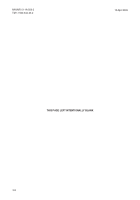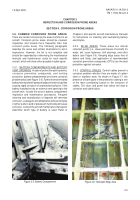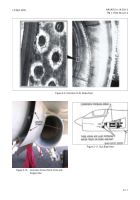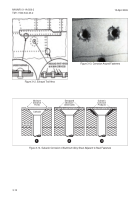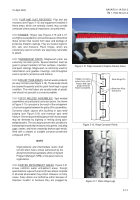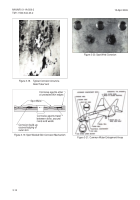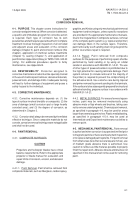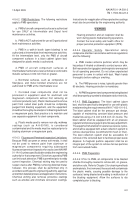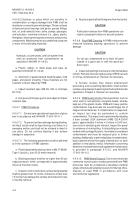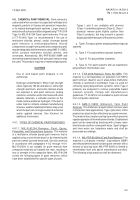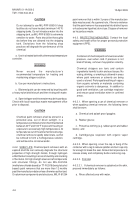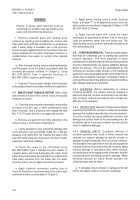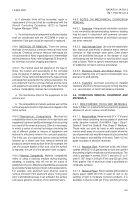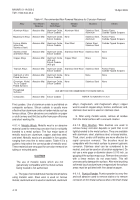TM-1-1500-344-23-2 - Page 77 of 240
4-1
NAVAIR 01-1A-509-2
TM 1-1500-344-23-2
15 April 2009
CHAPTER 4
CORROSION REMOVAL
4-1. PURPOSE
. This chapter covers instructions for
corrosion and paint removal. When corrosion is detected,
a specific and immediate program for corrective action
is required. Each type of corrosion has its own
peculiarities and will require special treatment. Complete
treatment involves thorough inspection of all corroded
and adjacent areas and evaluation of the corrosion
damage (Chapter 3), paint and corrosion removal (this
chapter), application of chemical surface treatments
(Chapter 5), sealing (Chapter 7), and application of
paint finishes: Appendix A (Navy) or TM 55-1500-345-23
(Army). For additional procedures specific to Army
maintenance, see Appendix B.
4-2. RESPONSIBILITY
. Personnel assigned to
corrective maintenance tasks must be specially trained
in the use of chemical paint remover, abrasive materials,
powered tools, and damage limits. Inadequate training
will lead to further damage of equipment and poses a
safety hazard to the individual.
4-3. CORRECTIVE MAINTENANCE
.
4-3.1. Corrective maintenance depends on: (1) the
type of surface involved (metallic or composite); (2) the
area of damage (small corrosion spot or large heavily
corroded area); and (3) the degree of corrosion, as
determined in Chapter 3.
4-3.2. Corrosion shall always be removed by the mildest
effective technique. Since composite materials do not
corrode, corrosion removal techniques are not applicable
and shall not be used.
4-4. PAINT REMOVAL.
4-4.1. COMPOSITE SURFACES.
CAUTION
Propellers and helicopter blades have critical
balance requirements. Refer to the appropriate
propeller or blade manual for evaluation and
repair limits of corrosion, erosion, and abrasion
damage.
4-4.1.1. Paint Removal. Paint shall be removed from
composite materials, such as fiberglass, carbon/epoxy,
graphite, and Kevlar using only mechanical paint removal
equipment and techniques, unless specific exceptions
are provided in the appropriate maintenance manuals.
Due to the irregularities in composite surfaces, removal
of the complete paint system (e.g. topcoat and primer)
can damage fibers in the surface layers. Therefore,
paint removal by scuff sanding shall not go beyond the
primer coat unless repair is required.
4-4.1.2. Repair. Paint removed from composite
surfaces for the purposes of performing repairs shall be
performed by hand sanding or by using an orbital
sander in accordance with NAVAIR 01-1A-21. The use
of other types of powered sanders is prohibited due to
the high potential for causing laminate damage. Paint
system removal (to include removal of the majority of
the primer) is required to prevent the compromising of
the adhesive bond. Use extreme care during topcoat
and primer removal to prevent sanding into the laminate.
If the surface is to be subsequently prepared for structural
adhesive bonding, prepare surface in accordance with
NAVAIR 01-1A-21.
4-4.2. METAL SURFACES. For areas of several square
inches, paint may be removed mechanically using
abrasive mats or flap wheels and brushes, taking care
not to remove underlying metal. Chemical paint removal,
as specified in paragraph 4-6, may be used for areas
larger than several square inches. Plastic media blasting,
as specified in paragraph 4-5.4, may be used at
Intermediate and Depot level maintenance activities to
remove paint.
4-5. MECHANICAL PAINT REMOVAL.
Paint removal
is authorized when corrosion is suspected/verified prior
to magnetic particle or fluorescent penetrant inspection,
or to replace damaged paint systems. For paint removal
from small areas (less than several square inches), use
of medium grade abrasive mats is authorized. Use
caution to remove as little metal as possible to properly
finish the repair work. Abrasive wheels and brushes not
specified in this manual shall not be used for removing
paint.
Back to Top


